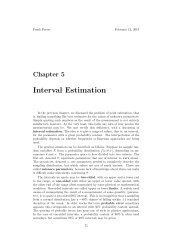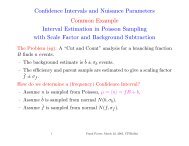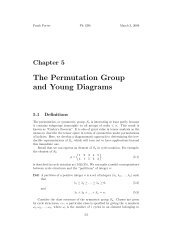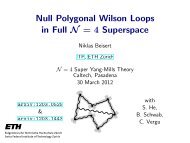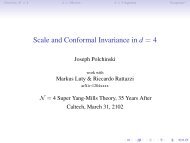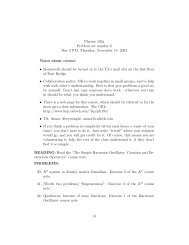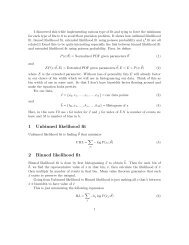1 Introduction 2 Resolvents and Green's Functions
1 Introduction 2 Resolvents and Green's Functions
1 Introduction 2 Resolvents and Green's Functions
You also want an ePaper? Increase the reach of your titles
YUMPU automatically turns print PDFs into web optimized ePapers that Google loves.
Course Notes<br />
Solving the Schrödinger Equation: <strong>Resolvents</strong><br />
051117 F. Porter<br />
Revision 111109 F. Porter<br />
1 <strong>Introduction</strong><br />
Once a system is well-specified, the problem posed in non-relativistic quantum<br />
mechanics is to solve the Schrödinger equation. Once the solutions are<br />
known, then any question of interest can in principle be answered, by taking<br />
appropriate expectation values of operators between states made from the<br />
solutions. There are many approaches to obtaining the solutions, analytic,<br />
approximate, partial, <strong>and</strong> numerical. All have important applications. In<br />
this note, we exam the approach of obtaining analytic solutions using conventional<br />
methods of analysis. In particular, we develop a means to apply<br />
the powerful techniques of complex analysis to this problem.<br />
2 <strong>Resolvents</strong> <strong>and</strong> Green’s <strong>Functions</strong><br />
We have already considered the interpretation of a function of a self-adjoint<br />
operator Q, with point spectrum (eigenvalues) Σ(Q) = {q i ; i = 1, 2, . . .}, <strong>and</strong><br />
spectral resolution<br />
∞∑<br />
Q = q k |k〉〈k|, (1)<br />
where<br />
k=1<br />
Q|k〉 = q k |k〉 (2)<br />
〈k|j〉 = δ kj (3)<br />
I =<br />
∞∑<br />
|k〉〈k|. (4)<br />
In particular, the eigenvectors of Q form a complete orthonormal set.<br />
If f(q) is any function defined on Σ(Q), then we define<br />
k=1<br />
f(Q) = ∑ k<br />
f(q k )|k〉〈k|. (5)<br />
It may be observed that [f(Q), Q] = 0. If f(q) is defined <strong>and</strong> bounded on<br />
Σ(Q), then f(Q) is a bounded operator, where the norm of an operator is<br />
1
defined according to:<br />
‖f(Q)‖op ≡ sup ‖f(Q)φ‖ (6)<br />
‖φ‖=1<br />
= sup |f(q)| (7)<br />
q∈Σ(Q)<br />
< ∞, if f(q) is bounded. (8)<br />
Now define an operator-valued function G(z), called the resolvent of Q,<br />
of complex variable z, for all z not in Σ(Q) by: 1<br />
G(z) = 1 , z /∈ Σ(Q). (9)<br />
Q − z<br />
For any such z the operator G(z) is bounded, <strong>and</strong> we have<br />
‖G(z)‖op = sup<br />
k<br />
1<br />
|q k − z| . (10)<br />
The resolvent satisfies the identities<br />
G(z) − G(z 0 ) = ∑ ( 1<br />
k<br />
q k − z − 1 )<br />
|k〉〈k|<br />
q k − z 0<br />
= ∑ z − z 0<br />
k<br />
(q k − z)(q k − z 0 ) |k〉〈k|<br />
z − z 0<br />
=<br />
(Q − z)(Q − z 0 )<br />
= (z − z 0 )G(z)G(z 0 ), (11)<br />
<strong>and</strong><br />
G(z) =<br />
G(z 0 )<br />
1 + (z 0 − z)G(z 0 ) , (12)<br />
Q = z + 1/G(z). (13)<br />
If the eigenvectors are written as functions of x ∈ R 3 (assuming that<br />
the Hilbert space is L 2 (R 3 )), we can represent the resolvent as an integral<br />
transform on the wave functions. That is, with<br />
G(z) = 1<br />
Q − z = ∑ k<br />
|k〉〈k|<br />
q k − z , (14)<br />
1 The resolvent is sometimes defined with the opposite sign. We shall see eventually<br />
that G(z) also finds motivation in terms of Cauchy’s integral formula.<br />
2
<strong>and</strong><br />
|k〉 = φ k (x), (15)<br />
we define<br />
G(x, y; z) = ∑ φ k (x)φ ∗ k(y)<br />
, (16)<br />
k<br />
q k − z<br />
so that G operates on a wave function according to<br />
∫<br />
[G(z)ψ] (x) = d 3 (y)G(x, y; z)ψ(y). (17)<br />
(∞)<br />
Thus G(x, y; z) is the kernel of an integral transform. We may see that this<br />
correspondence is as claimed as follows: Exp<strong>and</strong><br />
ψ(y) = ∑ l<br />
ψ l φ l (y). (18)<br />
Then<br />
∫<br />
d 3 (y) ∑ φ k (x)φ ∗ k(y) ∑<br />
ψ l φ l (y)<br />
(∞)<br />
k<br />
q k − z<br />
l<br />
= ∑ φ k (x) ∑<br />
∫<br />
ψ l d 3 (y)φ ∗<br />
k<br />
q k − z<br />
k(y)φ l (y)<br />
l<br />
(∞)<br />
= ∑ ψ k φ k (x)<br />
k<br />
q k − z . (19)<br />
This is to be compared with<br />
[G(z)ψ] (x) = ∑ k<br />
= ∑ k<br />
1<br />
q k − z |k〉〈k| ∑ ψ l |l〉<br />
l<br />
ψ k φ k (x)<br />
q k − z . (20)<br />
We have thus demonstrated the representation as an integral transform. Similar<br />
results would apply on other L 2 spaces of wave functions besides L 2 (R 3 ).<br />
Consider now the formal relation:<br />
1<br />
(Q − z)G(z) = (Q − z) = I. (21)<br />
Q − z<br />
Corresponding to this, we have operator: 2<br />
(Q x − z)G(x, y; z) = δ (3) (x − y), (22)<br />
2 We use a subscript x on Q to denote that, if, for example, Q is a differential operator,<br />
the differentiation is on variable x.<br />
3
since δ (3) (x − y) is the kernel corresponding to I. This delta-function is thus<br />
symbolic of the relation:<br />
∫<br />
(Q x − z) d (3) (y)G(x, y; z)ψ(y) = ψ(x), (23)<br />
(∞)<br />
for any continuous ψ(x) in L 2 (R 3 ) (continuous in case Q is a differential<br />
operator).<br />
The kernel G(x, y; z) is called the Green’s function for the (differential)<br />
operator Q. This Green’s function is the “kernel for a resolvent”(as with<br />
the resolvent, the sign convention is not universal). It is the solution of the<br />
inhomogeneous differential equation (Eqn. 22) for an “impulse source”, which<br />
satisfies “the” boundary conditions since it may be expressed in an expansion<br />
of basis vectors satisfying the boundary conditions:<br />
G(x, y; z) =<br />
∞∑<br />
k=1<br />
From this relation, we also see the symmetry property:<br />
Our definition of G(z) ≡ 1<br />
Q−z<br />
φ k (x)φ ∗ k(y)<br />
. (24)<br />
q k − z<br />
G(x, y; z) ∗ = G(y, x; z ∗ ). (25)<br />
suggests that the resolvent is an analytic<br />
(operator-valued) function of z in the complement of the spectrum of Q. For<br />
any point z 0 /∈ Σ(Q), we have the power series:<br />
∞∑<br />
G(z) = G(z 0 ) [(z − z 0 )G(z 0 )] n . (26)<br />
n=0<br />
This series converges in norm inside any disk |z − z 0 | < ρ which does not<br />
intersect Σ(Q). Further, for the n th term in the series, we have<br />
where<br />
‖G(z 0 ) [(z − z 0 )G(z 0 )] n ‖op ≤<br />
( ρ<br />
ρ 0<br />
) n<br />
1<br />
ρ 0<br />
, (27)<br />
1<br />
ρ 0<br />
= ‖G(z 0 )‖op = distance [z 0 , Σ(Q)] . (28)<br />
Since the resolvent is “analytic” we may use contour integration. For example,<br />
in Fig. 1 we suppose that contour C 4 encircles a single, non-degenerate,<br />
eigenvalue q 4 . Then<br />
4
z<br />
.<br />
. . . . . . .<br />
q 4<br />
C 4<br />
Figure 1: The complex z plane, with eigenvalues of Q indicated on the real<br />
axis. A contour is shown encircling one of the eigenvalues.<br />
That is,<br />
∫<br />
1<br />
G(z) dz = 1 ∫<br />
2πi C 4 2πi C 4<br />
∫<br />
= 1<br />
2πi<br />
∞ ∑<br />
k=1<br />
C 4<br />
|φ 4 〉〈φ 4 |<br />
q 4 − z<br />
|k〉〈k|<br />
dz (29)<br />
q k − z<br />
dz (30)<br />
=<br />
( z − q4<br />
|φ 4 〉〈φ 4 | lim z→q4 q 4 − z<br />
(31)<br />
= −|φ 4 〉〈φ 4 |. (32)<br />
|φ 4 〉〈φ 4 | = − 1 ∫<br />
G(z) dz. (33)<br />
2πi C 4<br />
The contour integral of G around an eigenvalue of Q gives the projection<br />
onto the one-dimensional subspace of the corresponding eigenvector of Q.<br />
Now suppose that the spectrum of Q is bounded below, i.e., there exists<br />
an α > −∞ such that q k > α, ∀k. Of particular interest is the Hamiltonian,<br />
which has this property. In this case, we may consider a contour which<br />
encircles all eigenvalues, as in Fig. 2: Then we have<br />
I = − 1 ∫<br />
G(z) dz, (34)<br />
2πi C ∞<br />
as may be proven by a limiting process, <strong>and</strong> noting that convergence is all<br />
right.<br />
According to Cauchy’s integral formula, we can express analytic functions<br />
of Q in terms of contour integrals: Let f(z) be a function which is analytic<br />
)<br />
5
Ch<br />
. . . ..<br />
. . .. .<br />
q 1<br />
h<br />
h<br />
Figure 2: A contour which encircles the entire spectrum of Q.<br />
in a region which contains C ∞ . Then<br />
f(Q) = 1 ∫<br />
f(z) dz<br />
2πi C ∞ z − Q = − 1 ∫<br />
dzf(z)G(z), (35)<br />
2πi C ∞<br />
assuming the integral converges. In particular consider the function f(z) =<br />
e −izt :<br />
U(t) = e −itQ = − 1 ∫<br />
∞∑<br />
G(z)e −izt dz = |k〉〈k|e −itq k<br />
, (36)<br />
2πi C ∞<br />
with the restriction that Im(t) ≤ 0.<br />
The principal application of all this occurs when Q = H is the Hamiltonian.<br />
For real t in this case, U(t) is the time development transformation,<br />
or evolution operator. Note that it satisfies (assuming H carries no<br />
explicit time dependence):<br />
k=1<br />
i d dt U(t) = i d dt e−itH = HU(t) (37)<br />
U(0) = I. (38)<br />
We shall consider this case (Q = H) henceforth. The kernel of the integral<br />
transform representing U(t) is:<br />
U(x, y; t) = − 1 ∫<br />
dze −itz G(x, y; z) (39)<br />
2πi C ∞<br />
∞∑<br />
= φ k (x)φ ∗ k(y)e −iqkt . (40)<br />
k=1<br />
6
If we know U(x, y; t) then we can solve the time-dependent Schrödinger<br />
equation given any initial wave function. Corresponding to the above differential<br />
equation (Eqn. 37), we have for U(x, y; t):<br />
<strong>and</strong> initial condition<br />
i∂ t U(x, y; t) =<br />
∞∑<br />
φ k (x)φ ∗ k(y)q k e −iq kt<br />
k=1<br />
=<br />
∞∑<br />
H x φ k (x)φ ∗ k(y)e −iq kt<br />
k=1<br />
= H x U(x, y; t), (41)<br />
U(x, y; 0) = δ (3) (x − y). (42)<br />
Hence, if ψ(x) is any wave function, then ψ(x; t) defined by:<br />
∫<br />
ψ(x; t) ≡ d 3 (y)U(x, y; t)ψ(y) (43)<br />
(∞)<br />
satisfies the Schrödinger equation,<br />
<strong>and</strong> initial condition<br />
i∂ t ψ(x; t) = H x ψ(x; t), (44)<br />
ψ(x; 0) = ψ(x). (45)<br />
We remark that the resolvent <strong>and</strong> Green’s function, <strong>and</strong> U(t), actually<br />
exist for a larger class of operators, not just those with a pure point spectrum.<br />
For example, the resolvent exists for any self-adjoint operator which<br />
is bounded below. In particular, we have existence for the Hamiltonian of a<br />
free particle, with H = p 2 /2m. However, we cannot in general express G(z)<br />
<strong>and</strong> U(t) as sums over states, <strong>and</strong> the Green’s function cannot be expressed<br />
as a sum over products of eigenfunctions. The contour integral relation:<br />
U(x, y; t) = − 1<br />
2πi<br />
∫<br />
C ∞<br />
dze −itz G(x, y; z) (46)<br />
remains valid. We have resorted to the case with a pure point spectrum,<br />
with sums over states, in order to develop the feeling for how things work<br />
without getting bogged down in mathematical issues.<br />
3 Connection between Schrödinger Equation<br />
<strong>and</strong> Diffusion Equation<br />
Suppose<br />
H = − 1<br />
2m ∇2 + V (x), (47)<br />
7
<strong>and</strong> recall<br />
∞∑<br />
U(t) = e −itH = |k〉〈k|e iqkt . (48)<br />
k=1<br />
These relations still make sense mathematically if we consider imaginary<br />
times t = −iτ where τ ≥ 0:<br />
U(−iτ) = e −τH , (49)<br />
<strong>and</strong> then<br />
d<br />
U(−iτ) = −HU(−iτ). (50)<br />
dτ<br />
The corresponding equation for the kernel is thus:<br />
∂ τ U(x, y; −iτ) = −H x U(x, y; −iτ)<br />
= 1<br />
2m ∇2 xU(x, y; −iτ) − V (x)U(x, y; −iτ). (51)<br />
This is in the form of a diffusion equation. Thus, the Schrödinger equation<br />
is closely related to a diffusion equation, corresponding to the Schrödinger<br />
equation with imaginary time.<br />
However, there is a difference. The Schrödinger equation can be solved in<br />
both time directions – “backward prediction” is all right. But the diffusion<br />
equation can, for general initial conditions, only be solved in the forward time<br />
direction. This is because the operator U(−iτ) = e −τH has the entire Hilbert<br />
space as its domain for τ > 0, but not for τ < 0 (since e −τH = ∑ k e −τω k |k〉〈k|,<br />
<strong>and</strong> the e −τω k “weight” has unbounded contributions for τ < 0. On the other<br />
h<strong>and</strong> U(t) = e −itH is a unitary operator for all real t, <strong>and</strong> hence the entire<br />
Hilbert space is its domain for all real t.<br />
4 A Brief Revisit to Statistical Mechanics<br />
In the note on density matrices we gave the density matrix for the canonical<br />
thermodynamic distribution. With U(t) = e itH , we may also write it in terms<br />
of U:<br />
ρ(T ) = e−H/T<br />
Z(T ) = 1 U(−i/T ), (52)<br />
Z(T )<br />
where we have made the substitution t = −i/T . As long as T ≥ 0, this substitution<br />
is mathematically acceptable. The inverse temperature corresponds<br />
to an imaginary time coordinate. With this substitution, we also have the<br />
8
partition function:<br />
Z(T ) = Tr ( e −H/T )<br />
= Tr [U(−i/T )]<br />
∫<br />
(53)<br />
= d 3 (x)U(x, x; −i/T ). (54)<br />
(∞)<br />
5 Practical Matters<br />
We see that the objects G(z), U(z), etc., are potentially very useful tools<br />
towards solving the Schrödinger equation, calculating the partition function,<br />
<strong>and</strong> perhaps other applications. We’ll also make the connection of<br />
G(z) with perturbation theory later. Let us here address the question of<br />
how one goes about constructing these tools in practice in an explicit problem.<br />
“Closed form” solutions for the Green’s function exist for special cases<br />
(with special symmetries of H), <strong>and</strong> useful forms can be constructed for<br />
one-dimensional problems (hence also for spherically symmetric problems in<br />
three-dimensions). Otherwise, we can attempt to apply perturbation theory<br />
methods towards obtaining useful approximations.<br />
5.1 General Procedure to Construct the Green’s Function<br />
for a One-dimensional Schrödinger Equation<br />
Let<br />
H = − 1 + V (x), (55)<br />
2m dx2 where x ∈ (a, b) (<strong>and</strong> a → −∞, b → ∞ is permissible). The Hilbert space is<br />
L 2 (a, b). Assume V (x) is such that H is bounded below.<br />
Let z be a complex number with Im(z) ≠ 0, <strong>and</strong> consider solutions u(x; z)<br />
of the following differential equation:<br />
d 2<br />
Hu(x; z) = zu(x; z), (56)<br />
with boundary condition that the solutions must vanish at the endpoints of<br />
the interval. Let u L (x; z) be a solution satisfying the boundary conditions at<br />
the left endpoint, <strong>and</strong> let u R (x; z) be a solution satisfying the boundary conditions<br />
at the right endpoint. Consider the quantity, called the Wronskian:<br />
W (z) ≡ u ′ L(x; z)u R (x; z) − u L (x; z)u ′ R(x; z). (57)<br />
9
We only give the Wronskian a z argument, because it has the remarkable<br />
property that is is independent of x:<br />
dW<br />
dx<br />
= u ′′ Lu R − u L u ′′ R<br />
= −2m(z − V )u L u R − u L [−2m(z − V )] u R<br />
= 0. (58)<br />
Thus, the Wronskian may be evaluated at any convenient value of x.<br />
Now define<br />
G(x, y; z) ≡<br />
2m<br />
W (z) [u L(x; z)u R (y; z)θ(y − x) + u L (y; z)u R (x; z)θ(x − y)] ,<br />
x where the step function θ(x) is defined by:<br />
⎧<br />
⎨ 0 if x < 0,<br />
θ(x) ≡<br />
⎩<br />
1/2 if x = 0<br />
1 if x > 0.<br />
(59)<br />
(60)<br />
Since u L <strong>and</strong> u R are continuous functions on (a, b), with continuous first<br />
derivatives (in order to be in the domain of H), it follows that<br />
1. G(x, y; z) is a continuous function of x, for x ∈ (a, b).<br />
2. G(x, y; z) is a differentiable function of x, <strong>and</strong> the first derivative is<br />
continuous at all points x ∈ (a, b), except for x = y, where there is a<br />
discontinuity of magnitude:<br />
lim<br />
ɛ→0 + [(∂ 1G)(x + ɛ, x; z) − (∂ 1 G)(x − ɛ, x; z)] = −2m, (61)<br />
where the notation ∂ 1 is used to mean “differentiation with respect to<br />
the first argument”.<br />
3. For x ≠ y, G satisfies the differential equation<br />
H x G(x, y; z) = zG(x, y; z), (x ≠ y). (62)<br />
We may include the point x = y by writing<br />
(H x − z)G(x, y; z) = δ(x − y). (63)<br />
This corresponds to the right magnitude for the discontinuity in the<br />
first derivative.<br />
10
4. If H is self-adjoint, then G(x, y; z) is, in fact, our earlier discussed<br />
Green’s function. It is given by Eqn. 59 for all z (including real z),<br />
not in the spectrum of H. The discrete eigenvalues of H correspond to<br />
poles of G as a function of z. Thus, the bound states can be found by<br />
searching for the poles of G, in a suitably cut complex plane (if H has<br />
a continuous spectrum, we have a branch cut).<br />
5.2 Example: Force-free Motion<br />
Let us evaluate the Green’s function for force-free motion, V (x) = 0, in<br />
x ∈ (−∞, ∞) configuration space:<br />
d 2<br />
Hu(x; z) = − 1 u(x; z) = zu(x; z). (64)<br />
2m dx2 We must have u L → 0 as x → −∞, <strong>and</strong> u R → 0 as x → ∞. Then we have<br />
solutions of the form:<br />
where<br />
u L (x; z) = e −iρx , u R (x; z) = e iρx , (65)<br />
ρ = √ 2mz. (66)<br />
We select the branch of the square root so that the imaginary part of ρ is<br />
positive, as long as z is not along the non-negative real axis. We know that<br />
the spectrum of H is the non-negative real axis. Thus, we cut the z-plane<br />
along the positive real axis.<br />
To obtain the Wronskian, note that u ′ L = −iρu L <strong>and</strong> u ′ R = iρu R . Evaluate<br />
at x = 0 for convenience: u L (0) = u R (0) = 1. Hence,<br />
W (z) = (−iρ) − (iρ) = −2iρ = −2i √ 2mz. (67)<br />
Thus, we obtain the Green’s function:<br />
G(x, y; z) =<br />
2m<br />
−2i √ 2mz<br />
[<br />
e −iρx e iρy θ(y − x) + e −iρy e iρx θ(x − y) ]<br />
= i√ m<br />
2z eiρ|x−y| . (68)<br />
We could have noticed from the start that G had to be a function of (x − y)<br />
only, by the translational invariance of the problem.<br />
Let us continue, <strong>and</strong> obtain the time development transformation U(x, y; t):<br />
U(x, y; t) = − 1 ∫<br />
dze −itz G(x, y; z), (69)<br />
2πi C ∞<br />
11
C h<br />
(a)<br />
z<br />
C h<br />
ρ<br />
(b)<br />
Figure 3: The contour C ∞ : (a) in the z plane; (b) in the ρ plane.<br />
where C ∞ is the contour in Fig. 3. With ρ 2 = 2mz, we may make the<br />
substitution z = ρ 2 /2m <strong>and</strong> dz = ρdρ/m, to obtain the integral in the ρ<br />
plane:<br />
U(x, y; t) = − im ∫ −∞+iɛ dρ /2m<br />
2πi ∞+iɛ m e−itρ2 e iρ|x−y| . (70)<br />
We may take the ɛ → 0 limit, <strong>and</strong> guarantee convergence by evaluating the<br />
integral at complex time t → t − iτ, where τ > 0:<br />
U(x, y; t − iτ) = 1 ∫ ∞<br />
dρ exp<br />
2π −∞<br />
{<br />
−<br />
[<br />
ρ 2 ( 1<br />
2m (τ + it) )<br />
− ρi|x − y|<br />
]}<br />
. (71)<br />
We compute by completing the square in the exponent:<br />
⎧ [ √ ⎫<br />
U(x, y; t − iτ) = 1 ∫ ∞<br />
⎪⎨ ρ − a/ 1<br />
2π ea2 dρ exp<br />
−∞ ⎪⎩ − (τ + 2m it)] 2 ⎪⎬<br />
, (72)<br />
2σ 2 ⎪ ⎭<br />
where<br />
a = i |x − y|<br />
√<br />
2 1<br />
2m<br />
(73)<br />
σ = √ 1 1<br />
2 (τ + it).<br />
(74)<br />
√ 1<br />
2m<br />
12
The integral is now in the form of the integral of a Gaussian, <strong>and</strong> has the<br />
value √ 2πσ. Therefore,<br />
U(x, y; t − iτ) = 1 √ 1 2π √<br />
2π<br />
1<br />
(τ + it)ea2<br />
2m<br />
√<br />
[<br />
]<br />
m<br />
=<br />
2π(τ + it) exp m(x − y)2<br />
− , (75)<br />
2(τ + it)<br />
with Re √ τ + it > 0.<br />
It is interesting to look at this result for t = 0:<br />
√ [<br />
]<br />
m<br />
U(x, y, −iτ) =<br />
2πτ exp m(x − y)2<br />
− . (76)<br />
2τ<br />
Referring back to our earlier discussion, we see that this gives the solution<br />
to the diffusion equation, or, for example, to the heat conduction problem<br />
(for a homogeneous medium) with an initial heat distribution proportional to<br />
δ(x − y). As time τ increases, the heat propagates out from x = y, spreading<br />
according to a broadening Gaussian.<br />
In quantum mechanics, we are more interested in the limit τ → 0 + . The<br />
only subtle issue is the phase in √ τ + it. Let<br />
√<br />
τ + it =<br />
√<br />
Re<br />
iθ<br />
= √ Re iθ/2 , (77)<br />
→<br />
where R = √ τ 2 + t 2 |t|. Referring to Fig. 4, for t > 0 we have 0 <<br />
τ→0 +<br />
θ < π/2, approaching θ = π/2 as τ → 0 + . Similarly, for t < 0 we have<br />
−π/2 < θ < 0, approaching θ = −π/2 as τ → 0 + . Hence,<br />
⎧<br />
√ √ ⎨ e iπ/4 = √ 1<br />
τ + it →τ→0 + |t|<br />
2<br />
(1 + i), t > 0,<br />
⎩ e −iπ/4 = √ 1<br />
(78)<br />
2<br />
(1 − i), t < 0.<br />
Thus,<br />
U(x, y; t) = 1 2<br />
(<br />
1 − i t ) √ [ ]<br />
m im(x − y)<br />
2<br />
|t| 2π|t| exp . (79)<br />
2t<br />
This is the time development transformation for the free particle Schrödinger<br />
equation in one dimension, where we have kept proper track of the phase for<br />
all times.<br />
We may check that the behavior of this transformation is as expected<br />
when we transform by time t, followed by transforming by time −t. The<br />
result ought to be what we started with, i.e., this product should be the<br />
identity. Thus, we consider the product<br />
U(y 2 , x; −t)U(x, y 1 ; t) =<br />
m<br />
2π|t| exp { im<br />
2t<br />
[<br />
(x − y1 ) 2 − (x − y 2 ) 2]} . (80)<br />
13
it<br />
R<br />
θ<br />
Re iθ<br />
τ<br />
Figure 4: Illustration to help in the evaluation of the phase of the free particle<br />
time development transformation.<br />
Integrating over the intermediate variable x:<br />
∫ ∞<br />
dxU(y 2 , x; −t)U(x, y 1 ; t) = m [ ] im 1<br />
|t| exp 2t (y2 1 − y2)<br />
2<br />
−∞<br />
This has the hoped-for behavior.<br />
5.3 Example: Reflecting Wall<br />
∫ ∞<br />
2π −∞<br />
= m [ ] [ ]<br />
im m<br />
|t| exp 2t (y2 1 − y2)<br />
2 δ<br />
t (y 2 − y 1 )<br />
[ ]<br />
im<br />
dx exp<br />
t (y 2 − y 1 )x<br />
= δ(y 2 − y 1 ). (81)<br />
The translation invariance of the example above will be lost if the configuration<br />
space is changed to a half-line x ∈ [0, ∞). This may be interpreted as a<br />
free-particle problem, except with a reflecting wall at x = 0. Again,<br />
H = − 1 d 2<br />
2m dx . (82)<br />
2<br />
14
We still have u R (x; z) = e iρx , but now the left boundary condition is u L (0; z) =<br />
0. Hence, a left solution is<br />
We obtain W = ρ, by evaluating at x = 0. Thus,<br />
u L (x; z) = sin(ρx). (83)<br />
G(x, y; z) = 2m [<br />
sin(ρx)e iρy θ(y − x) + sin(ρy)e iρx θ(x − y) ]<br />
ρ<br />
= m [(<br />
e iρ(x+y) − e iρ(y−x)) θ(y − x) + ( e iρ(x+y) − e iρ(x−y)) θ(x − y) ]<br />
iρ<br />
√ m [<br />
= i e iρ|x−y| − e iρ(x+y)] . (84)<br />
2z<br />
This Green’s function is not translation invariant. However, if x → ∞,<br />
y → ∞ such that x − y is finite, then this Green’s function tends toward<br />
our first example (Imρ > 0 is still our branch). This is compatible with the<br />
intuition that the local physics far from the wall at x = 0 should be nearly<br />
independent of the existence of the wall.<br />
5.4 Example: Force-free Motion in Three Dimensions<br />
Consider the Green’s function problem for force-free motion in three dimensions:<br />
H = − 1<br />
2m ∇2 , (85)<br />
where x ∈ R 3 . The resolvent is most easily found in momentum space, since<br />
H = p 2 /2m is just multiplication by a factor there. Hence, the resolvent in<br />
momentum space is:<br />
1<br />
G(z) =<br />
p 2<br />
− z . (86)<br />
2m<br />
The Green’s function in momentum space is, formally:<br />
G(x, y; z) = ∑ k<br />
φ k (x)φ ∗ k(y)<br />
, (87)<br />
ω k − z<br />
where<br />
ω k = p2<br />
2m , (88)<br />
1<br />
φ k (x) = eip·x . (89)<br />
(2π) 3/2<br />
15
That is,<br />
G(x, y; z) = 1 d<br />
(2π)<br />
∫(∞)<br />
3 1<br />
(p) eip·(x−y) 3 p 2<br />
− z . (90)<br />
2m<br />
To evaluate this integral, let us first evaluate another h<strong>and</strong>y integral, the<br />
Fourier transform of the “Yukawa potential”:<br />
Y =<br />
=<br />
∫<br />
d 3 (x)e<br />
(∞)<br />
∫ ∞ ∫ 1 ∫ 2π<br />
0 −1 0<br />
∫ ∞ ∫ 1<br />
−ix·p e−µr<br />
, where r ≡ |x| (91)<br />
4πr<br />
dφd cos θdrr 2 1 exp(−µr − irp cos θ), where x · p = rp cos θ<br />
4πr<br />
= 1 d cos θdrre −µr −irp cos θ<br />
e<br />
2 0 −1<br />
= i ∫ ∞<br />
dre ( −µr e −irp − e irp)<br />
2p 0<br />
= i ( 1<br />
2p µ + ip − 1 )<br />
µ − ip<br />
=<br />
1<br />
p 2 + µ 2 . (92)<br />
We notice in passing that the Coulomb potential corresponds to µ → 0, with<br />
Hence,<br />
∫<br />
(∞)<br />
d 3 (x)e −ix·p 1<br />
4π|x| = 1 p 2 . (93)<br />
The inverse Fourier transform theorem tells us that then:<br />
1<br />
(2π) 3/2 ∫(∞)<br />
G(x, y; z) =<br />
d s 1<br />
(p) eix·p = (2π)<br />
p 2 + µ 2<br />
1<br />
(2π) 3 ∫(∞)<br />
3/2 e−µ|x|<br />
d 3 1<br />
(p) ei(x−y)·p<br />
p 2<br />
− z 2m<br />
4π|x| . (94)<br />
= 2m e−iρ|x−y|<br />
4π|x − y| . (95)<br />
We have selected the branch of the square root function so that Imρ < 0.<br />
We could just as well have selected the branch with Imρ > 0, in which case<br />
the Green’s function is:<br />
G(x, y; z) = 2m eiρ|x−y|<br />
4π|x − y| ; ρ = √ 2mz. (96)<br />
16
6 Perturbation Theory with <strong>Resolvents</strong><br />
Let H <strong>and</strong> ¯H = H + V be self-adjoint operators. The choice of symbol is<br />
motivated by the fact that we are especially interested in the case in which<br />
H is a Hamiltonian, <strong>and</strong> ¯H is another Hamiltonian related to the first by the<br />
addition of a potential term. We form the resolvents (with z /∈ Σ(H), Σ( ¯H)):<br />
G(z) =<br />
Ḡ(z) =<br />
1<br />
H − z<br />
(97)<br />
1<br />
¯H − z = 1<br />
H + V − z . (98)<br />
Then, noting that<br />
V = 1<br />
Ḡ(z) − 1<br />
G(z) , (99)<br />
it may readily be verified that<br />
<strong>and</strong><br />
Ḡ(z) = G(z) − G(z)V Ḡ(z) = G(z) − Ḡ(z)V G(z) (100)<br />
Ḡ(z) = G(z) − G(z)V G(z) + G(z)V Ḡ(z)V G(z). (101)<br />
These identities are very important in perturbation theory – if G(z) is known<br />
for Hamiltonian H, then we may learn something about a perturbed Hamiltonian<br />
H + V .<br />
We could try to iterate these identities still further:<br />
Ḡ(z) = G(z) − Ḡ(z)V G(z)<br />
= G(z) − G(z)V G(z) + Ḡ(z)V G(z)V G(z)<br />
=<br />
N∑<br />
[−G(z)V ] n G(z) + (−) N+1 Ḡ(z) [V G(z)] N+1 . (102)<br />
n=0<br />
If V is such that the “remainder” term above approaches 0 as N → ∞, then<br />
we have the Liouville-Neumann Series:<br />
∞∑<br />
Ḡ(z) = G(z) [−V G(z)] n . (103)<br />
n=0<br />
We may state a convergence theorem:<br />
Theorem: Let H <strong>and</strong> V be self-adjoint operators. Let G(z) be the resolvent<br />
for H, <strong>and</strong> let D H ⊂ D V . If<br />
‖V φ‖ < α 1 ‖φ‖ + α 2 ‖Hφ‖, ∀φ ∈ D H , (104)<br />
where α 1 > 0 <strong>and</strong> 0 < α 2 < 1, then the Liouville-Neumann series<br />
converges in operator norm for some open region of the complex plane.<br />
17
Proof: Let ψ ∈ H <strong>and</strong> z /∈ Σ(H). Then<br />
since<br />
H<br />
H−z<br />
φ = G(z)ψ = 1<br />
H − z ψ ∈ D H, (105)<br />
is a bounded operator. By assumption we have<br />
‖V φ‖ = ‖V G(z)ψ‖ < α 1 ‖G(z)ψ‖ + α 2 ‖<br />
H ψ‖. (106)<br />
H − z<br />
Since ψ is arbitrary, this implies:<br />
‖V G(z)‖op < α 1 ‖G(z)‖op + α 2 ‖<br />
H<br />
H − z ‖ op. (107)<br />
Let z = x + iy (x, y real). Use<br />
to obtain<br />
‖f(H)‖op =<br />
sup |f(ω)|, (108)<br />
ω∈Σ(H)<br />
1<br />
‖G(z)‖op = ‖<br />
H − z ‖ 1<br />
op ≤<br />
∣ ∣<br />
x − z<br />
= 1<br />
|y| , (109)<br />
<strong>and</strong><br />
‖<br />
H<br />
H − z ‖ ω<br />
op = sup<br />
∣ ∣ < 1. (110)<br />
ω∈Σ(H) ω − z<br />
∣ ∣∣ ω<br />
The last part expresses the fact that lim ω→∞ ∣ = 1.<br />
We thus have<br />
ω−z<br />
‖V G(z)‖op < α 1<br />
|y| + α 2. (111)<br />
Since α 2 < 1, for large enough y = y 0 , say, we have the result<br />
‖V G(z)‖op < 1 whenever |y| > y 0 . (112)<br />
Hence, the series converges in operator norm whenever |y| > y 0 . 3<br />
This series is the basis for the Born expansion in scattering theory, as will<br />
be discussed in another note.<br />
Consider now the case where H is the Hamiltonian for force-free motion:<br />
H = − 1<br />
2m ∇2 , x ∈ R 3 , (113)<br />
3 If the spectrum of H is bounded below, it will also converge for x < x 0 , for small<br />
enough x 0 .<br />
18
y<br />
z<br />
y<br />
-y 0<br />
0<br />
x<br />
Figure 5: The region of convergence of the perturbation series is the unshaded<br />
area.<br />
V = V (x) is a potential function, <strong>and</strong> ¯H = H + V . Then the identity<br />
Ḡ(z) = G(z) − G(z)V Ḡ(z) (114)<br />
corresponds to the integral equation:<br />
∫<br />
Ḡ(x, y; z) = G(x, y; z) −<br />
(∞)<br />
d 3 (x ′ )G(x, x ′ ; z)V (x ′ )Ḡ(x′ , y; z), (115)<br />
<strong>and</strong><br />
Ḡ(z) = G(z) − G(z)V G(z) + G(z)V Ḡ(z)V G(z) (116)<br />
corresponds to:<br />
∫<br />
Ḡ(x, y; z) = G(x, y; z) − d 3 (x ′ )G(x, x ′ ; z)V (x ′ )G(x ′ , y; z) (117)<br />
(∞)<br />
∫ ∫<br />
+ d 3 (x ′ )d 3 (y ′ )G(x, x ′ ; z)V (x ′ )Ḡ(x′ , y ′ ; z)V (y ′ )G(y ′ , y; z),<br />
(∞)<br />
where z /∈ Σ(H), z /∈ Σ( ¯H).<br />
We can also express the Schrödinger Equation for eigenstates of the perturbed<br />
Hamiltonian in the form of an integral equation. Let ¯φ k be an<br />
eigenstate of ¯H, corresponding to eigenvalue ¯ωk . Use the identity Ḡ(z) =<br />
G(z) − G(z)V Ḡ(z), <strong>and</strong> operate on ¯φ k , noting that (¯ω k − z)Ḡ(z) ¯φ k = ¯φ k :<br />
¯φ k = (¯ω k − z)G(z) ¯φ k − G(z)V ¯φ k . (118)<br />
19
If ¯ω k /∈ Σ(H), we may now substitute z = ¯ω k to obtain:<br />
¯φ k = −G(¯ω k )V ¯φ k . (119)<br />
Using our free particle Green’s function, Eqn. 96, this corresponds to the<br />
integral equation:<br />
¯φ k (x) = − 2m<br />
4π<br />
∫<br />
(∞)<br />
d 3 (y) exp ( i √ 2m¯ω k |x − y| )<br />
|x − y|<br />
In the case of a discrete bound state spectrum (¯ω k < 0),<br />
V (y) ¯φ k (y). (120)<br />
i √ √<br />
2m¯ω k = − 2m|¯ω k | < 0, (121)<br />
<strong>and</strong> this portion of the integr<strong>and</strong> falls off rapidly as |y| becomes large. This<br />
equation can be more convenient for studying the properties of ¯φ k than using<br />
the Schrödinger equation itself.<br />
7 Exercises<br />
1. Prove identities 12 <strong>and</strong> 13.<br />
2. Prove the power series expansion for resolvent G(z) (Eqn. 26):<br />
∞∑<br />
G(z) = G(z 0 ) [(z − z 0 )G(z 0 )] n .<br />
n=0<br />
You may wish to attempt to do this either “directly”, or via iteration<br />
on the identity of Eqn. 11.<br />
3. Prove the result in Eqn. 34.<br />
4. Let’s consider once again the Hamiltonian<br />
d 2<br />
H = − 1<br />
2m dx , (122)<br />
2<br />
but now in configuration space x ∈ [a, b] (“infinite square well”).<br />
(a) Construct the Green’s function, G(x, y; z) for this problem.<br />
(b) From your answer to part (a), determine the spectrum of H.<br />
20
(c) Notice that, using<br />
G(x, y; z) =<br />
∞∑<br />
k=1<br />
φ k (x)φ ∗ k(y)<br />
, (123)<br />
ω k − z<br />
the normalized eigenstate, φ k (x), can be obtained by evaluating<br />
the residue of G at the pole z = ω k . Do this calculation, <strong>and</strong> check<br />
that your result is properly normalized.<br />
(d) Consider the limit a → −∞, b → ∞. Show, in this limit that<br />
G(x, y; z) tends to the Green’s function we obtain in this note for<br />
this Hamiltonian on x ∈ (−∞, ∞):<br />
G(x, y; z) = i√ m<br />
2z eiρ|x−y| . (124)<br />
5. Let us investigate the Green’s function for a slightly more complicated<br />
situation. Consider th potential:<br />
{ V |x| ≤ ∆<br />
V (x) =<br />
(125)<br />
0 |x| > ∆<br />
V<br />
_ ∞<br />
_ Δ<br />
Δ<br />
x<br />
∞<br />
Figure 6: The “finite square potential”.<br />
(a) Determine the Green’s function for a particle of mass m in this<br />
potential.<br />
Remarks: You will need to construct your “left” <strong>and</strong> “right” solutions<br />
by considering the three different regions of the potential,<br />
matching the functions <strong>and</strong> their first derivatives at the boundaries.<br />
Note that the “right” solution may be very simply obtained<br />
from the “left” solution by the symmetry of the problem. In your<br />
solution, let<br />
√<br />
ρ = 2m(z − V ) (126)<br />
ρ 0 = √ 2mz. (127)<br />
21
Make sure that you describe any cuts in the complex plane, <strong>and</strong><br />
your selected branch. You may find it convenient to express your<br />
answer to some extent in terms of the force-free Green’s function:<br />
G 0 (x, y; z) = im ρ eiρ 0|x−y| . (128)<br />
(b) Assume V > 0. Show that your Green’s function G(x, y; z) is<br />
analytic in your cut plane, with a branch point at z = 0.<br />
(c) Assume V < 0. Show that G(x, y; z) is analytic in your cut plane,<br />
except for a finite number of simple poles at the bound states of<br />
the Hamiltonian.<br />
6. Find the time development transformation U(x, y; t) for the one-dimensional<br />
harmonic oscillator:<br />
H = p2<br />
2m + k 2 x2 ,<br />
ω ≡<br />
Be sure to clearly specify any choice of branch.<br />
√<br />
k/m. (129)<br />
Note that you can approach this problem in different ways, e.g., by<br />
directly integrating the differential equation U must satisfy, or by considering<br />
its expansion in terms of eigenfunctions of H (<strong>and</strong> perhaps<br />
using the creation <strong>and</strong> annihilation operators).<br />
7. Let us investigate the application of the time development transformation<br />
for the harmonic oscillator that we computed in the previous<br />
exercise. Explicitly, let us consider the problem of finding the wave<br />
function at time t corresponding to an initial (t = 0) wave function:<br />
φ(x; 0) =<br />
( ) αmω 1/4 [<br />
exp − αmω ]<br />
2π<br />
4 (x − a)2 , (130)<br />
where α > 0. Our initial wave function thus corresponds to a Gaussian<br />
probability in position, with 〈x〉 = a, <strong>and</strong> 〈(x − a) 2 〉 = 1/αmω. Using<br />
U(x, y; t) we can solve for φ(x; t) in closed form with this initial wave<br />
function.<br />
(a) Solve for φ(x; t). Do not go to great effort to simplify your result<br />
in this part – we’ll consider a case with simple cancellations in<br />
part (b).<br />
22
(b) From your answer to part (a), show that, for α = 2:<br />
φ(x; t) = ( mω<br />
π ) 1 4 exp<br />
{<br />
− mω<br />
2 (x − a cos ωt)2 − iω 2<br />
You should give some thought to how you might have attacked this<br />
problem using “elementary methods”, without knowing U(x, y; t).<br />
(c) Notice that the choice α = 2 corresponds to an initial state wave<br />
function something like a “displaced” ground state wave function.<br />
Solve for the probability distribution to find the particle at x as<br />
a function of time (for α = 2). Your result should have a simple<br />
form <strong>and</strong> should have an obvious classical correspondence.<br />
[<br />
t + 2max sin ωt − m a2<br />
2 sin 2ωt ]}<br />
.<br />
(131)<br />
23




